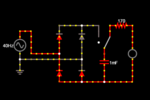dev514
Newbie level 4

Hi all,
I am struggling with a circuit calculation and quiet confused in analyzing the circuit.In the above shown image the input ac voltage is 4v and is rectified with bridge wave rectifier which is then fed to another circuit which stores and discharges the charge to a LED through a resistor.We use a SPDT switch in here.Which connects the capacitor with the bridge wave rectifier at one position and charges on the other hand when the switch is changed the capacitor is connected to the LED through resistor.My doubt is can i use time constant T=RC to calculate the charging time of capacitor.But how can i use T=RC when there is no resistor connected.The resistor is a capacitor discharge resistor so how do i calculate the charging and discharge time? and how to finally calculate the output voltage? :???:
thank you in advance...
Regards,
San